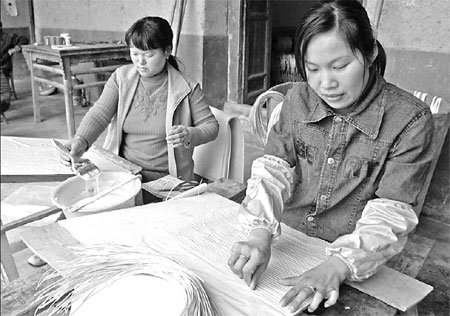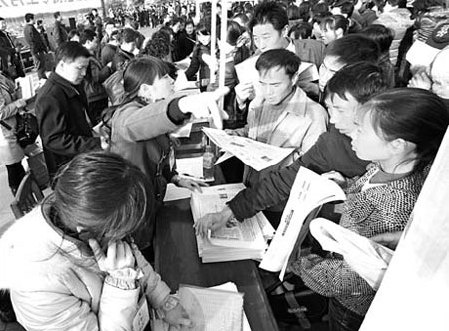Restless recovery
|
Two women from Zitong county, Sichuan province, make extra money by making packaging boxes. Cheng Heping |
Liu Daihe lights a cigarette passed on by his cousin and shuffles the mahjong tiles over the table. Puffing smoke into the tiny 20-sq-m temporary house, he settles down to idle away another day with friends and family.
It is a typical snapshot of life in the interim community to the north of Mianzhu, one of the most damaged cities of the May 12 earthquake that left more than 80,000 Chinese dead or missing.
Liu and his 40,000 fellow inhabitants are enveloped in an atmosphere of hope that contrasts with the utter grief suffered eight months ago.
Before the catastrophe, the 42-year-old father of two was a phosphorous miner for many years at Qingping town of Mianzhu. But the mine, one of the local pillar industries, was swallowed by the quake along with Liu's job.
As the breadwinner of the family, Liu looked for jobs elsewhere, but was turned down because of his age.
"I'm not competitive in the market," he says. "More importantly, I don't have technical skills, except from doing hard labor in the pit."
Financial assistance is also dwindling. Last year, the government handed out 200 yuan ($29) per person a month for eight months and 33.5 kilograms of grain per head for three months, but all the financial and material support ended in January, says Liu's cousin Liu Daishu.
"Nowadays, about 15 percent of the people in the community live on what they had before," he says.
The price of commodities has climbed because of rising transport costs, and Liu Daihe and his wife, Chen Mingfang, have to rack their brains to make ends meet.
What worries the couple most are the futures of their son, 14, and daughter, 18, who are studying at secondary school.

Daughter Changying will take the national college entrance examination this summer, meaning a huge amount of money will be needed if she is enrolled into university. This term alone, she paid 2,000-plus yuan ($292) for tuition fees and living expenses.
Her brother, Chenglin, pays 9 yuan ($1.3) a day for three meals in the school canteen as part of a boarder scheme.
Last September, Liu Daihe had to travel hundreds of kilometers away to work in a private mine in Yibin, southern Sichuan. He worked from 4 am to 4 pm for three months and was paid 80 yuan ($11.7) a day.
The pay was satisfactory, but the toil and loneliness in a strange city were intolerable. The man of few words killed time by playing mahjong with his colleagues, and sometimes, small-time gambling.
Unlike many parts of Sichuan, where the natural conditions are harsh, Mianzhu has fewer people moving to big cities, such as Beijing or Guangzhou, for job opportunities.
"Before the quake, Mianzhu was blessed with favorable conditions, with no storms or landslides, and most of us preferred to stay in our hometown," says Liu Daishu.
Adding to their sense of security was the multitude of industries sprawling across the city. National companies, such as Dongfang Turbine, Lonmon Chemicals and Jiannanchun Distillery, absorbed a large number of local workers.
"We are used to the pace of ease here," says Liu Daishu.
Statistics from the Bureau of Labor Resources and Social Security of Mianzhu confirm about 20,000 people were working outside Sichuan province, accounting less than one tenth the total labor force.
Before Spring Festival, Liu returned to work in the adjacent city of Shifang at another small mine, which was set up by one of his fellow villagers.
The pay was 50 yuan ($7.3) a day, but it was not guaranteed as he had expected. He was given two days off before Lantern Festival, because "the owner was short of explosives".
Employment has been a top priority since the earthquake. During the past year, the Mianzhu labor bureau has offered more than 18,000 public-welfare posts, such as warehouse store work or street sweeping.
Meanwhile, training programs in sewing and construction have covered about 6,000 people, according to Chen Shanyong, the bureau chief.
Jiangsu province, which is responsible for the point-to-point assistance to Mianzhu, offered another 50,000 jobs at five large job fairs, and 6,000 locals were taken to the coastal province.
"In spite of the earthquake, we didn't encounter major problems in employment creation last year," Chen says.
But the reality turns out to be less positive. Liu's niece, Jiang Mingyu, says it is difficult to set up her own tailor shop, which the government encourages.
"Where can I get the initial funding to launch my business?" she asks.
"It's true that they have in place micro credit loans, but the plan targets university graduates or young farmers.
"We don't have cash in the pocket for a change of life, so it's better to stay at home and do nothing as it saves money."
Women face much greater disadvantages. During the day, Chen Mingfang goes to the nearby construction site to do odd jobs, such as mixing cement or carrying bricks, but even such basic labor is not readily available.
"I often move around different places," Chen says, wiping her brow in the kitchen shared by 10 families.
Meanwhile, the re-location of Dongfang Turbine from the Hanwang town of Mianzhu to Deyang city is viewed as a deadly blow because many small businesses surrounding the large factory had relied on it for their own livelihoods.
Export-oriented companies such as Shengda Clothing and Lonmon Chemicals have been hard hit by the financial crisis.
|
A job fair draws a large crowd of local farmers in Guangyuan, Sichuan province. Liu Ren |
If jobs are the first priority, then housing is a close second. "A stable house drives home a sense of security, doesn't it?" says Liu Daishu.
For the moment, the 40,000 inhabitants in Liu's 11,000-household community have no clear idea where their permanent homes will be, because the new town plan has yet to be drawn up.
The government of Mianzhu has agreed to provide a 16,000-yuan ($2,341) subsidy to each family but that is far from enough to build a house, says Liu.
The cost of construction materials is a worry. The price of bricks have more than doubled from 0.6 yuan to 1.4 yuan and house construction costs have reached 820 yuan ($120) per square meter, estimates Liu Daishu. "This is unaffordable to most of us," he says.
A survey by Hong Kong Polytechnic University (HKPU) of the 1,600 households in Qingping in February suggests that each family lost 60,000 yuan ($8,777) in assets on average.
"The most difficult time - the psychological pain - is over, but it is replaced by confusion about the future," says Zhu Yuxin, a social work teacher from Sichuan Agricultural University, who heads the Assets-based Community Reconstruction program in Qingping under the sponsorship of HKPU.
"Our central guideline is to explore and integrate the inner strength of the fractured communities, so that effective means of livelihood will be secured.
"Right now, I'm also caught up by the complexity of problems. All that we can do is to make a detailed survey, right from the beginning."
(China Daily 04/06/2009 page8)
















